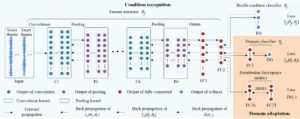Deep Convolutional Transfer Learning Network: A New Method for Intelligent Fault Diagnosis of Machines with Unlabeled Data
Liang Guo, Yaguo Lei, Saibo Xing, Tao Yan, and Naipeng Li
Extended abstract:
Intelligent fault diagnosis is able to handle massive monitoring data and distinguish health conditions of machines, which has attracted much attention from both researchers and engineers recently. Generally, the success of intelligent fault diagnosis relies on two conditions: 1) Labeled data are available to provide fault information. 2) The training and testing data are subject to the same probability distribution. However, for some machines, it is difficult to satisfy the above two conditions due to the following aspects. 1) Labeled fault data are difficult to obtain from some machines. 2) An intelligent fault diagnosis method trained with labeled data acquired from one machine possibly fails in classifying unlabeled data acquired from other machines. The above two aspects limit the applications of intelligent methods in diagnosing mechanical faults. As a potential tool to solve the above problem, transfer learning is equipped with the ability to reduce the distribution discrepancy between a source domain and the target domain.

This paper proposes a new intelligent method named deep convolutional transfer learning network (DCTLN) to diagnose mechanical faults without labeled data available. DCTLN consists of two modules: condition recognition and domain adaptation. The condition recognition module is constructed by a one-dimensional convolutional neural network to automatically learn features and recognize health conditions. The domain adaptation module facilitates the one-dimensional convolutional neural network to learn domain invariant features by maximizing domain recognition errors and minimizing probability distribution distance. With those two modules, DCTLN trained with labeled data acquired from one machine is expected to effectively classify the unlabeled data acquired from other machines. In order to demonstrate the effectiveness of the proposed DCTLN, five methods are used for comparison on six transfer fault diagnosis experiments of bearings. In those experiments, the proposed DCTLN obtain higher recognition accuracies compared with other methods. Specially, it improves the recognition accuracies of bearing health conditions by about 32.1% compared with traditional methods without transfer learning. Such results indicate that DCTLN trained with labeled data acquired from one machine is able to effectively classify unlabeled data acquired from other machines. Therefore, the proposed DCTLN promotes the successful applications of intelligent fault diagnosis of machines when no labeled data are available.

